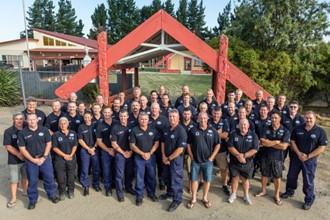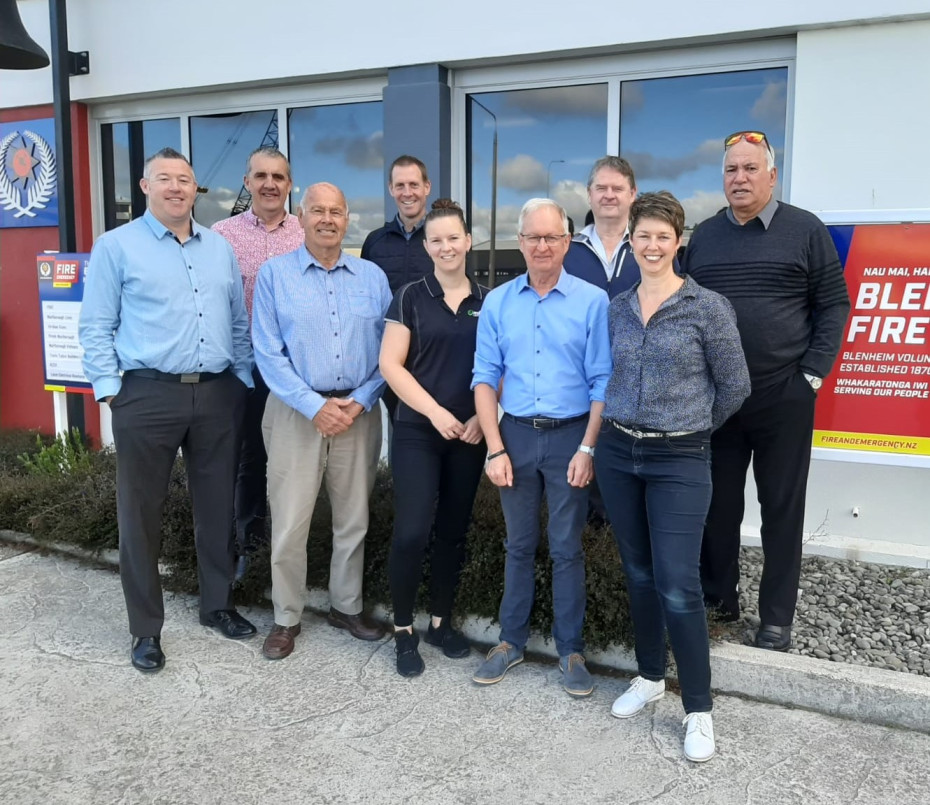LAC News and Updates
Find out more about Local Advisory Committee activities.
Use this space to note any additional information about your escape plan, i.e. who will assist
Smoke is poisonous and more deadly than flames.
If you breathe smoke for more than a few breaths it can kill you.
A house fire can kill you in less than three minutes.
Don't spend time trying to save possessions.
A closed door buys you time.
It slows down the spread of fire, giving you more time to get to safety.
People have died by going back into a fire.
Don't leave the meeting place to go back inside for any reason.
Find out more about Local Advisory Committee activities.
On this page

West Coast – December 2024
The West Coast Local Advisory Committee (LAC) played a key role in helping Fire and Emergency develop a series of Readiness and Recovery educational videos. These videos, created on the West Coast, explore the social, economic, natural, built, cultural, and rural environments and how emergencies impact each.
‘The aim of the videos is to show the importance of listening to the different voices within impacted communities and taking these into account not only in our recovery activities but also during response and readiness phases’, says Principal Advisor Recovery, Michelle Griffiths.
The West Coast LAC Chair, Shoshy Perchig-Gibli, connected the team working on the videos with members of the local businesses, inviting them along to a hui with the whole Community Risk Management team to discuss the video project. Through this collaboration, the group identified key areas of focus and provided valuable insights into the development of the videos.
West Coast LAC member and CEO of Development West Coast, Heath Milne, features in the videos to talk about social and economic impacts facing the region.
Heath adds, ‘I hope that by providing insights into the local economy, and the risks and opportunities we face as a community, we can work together with Fire and Emergency and other agencies to build West Coast’s resilience.’
Michelle says that involving the West Coast LAC in the development of these educational videos has been a ‘no-brainer.’ Her advice to others who may be looking for the all-important local community insights to help plan any relief or recovery activities is ‘involve the committee as soon as possible, right from the beginning.’

Otago – August 2024
A core function of Local Advisory Committees (LACs) is to consider and promote the interests of Fire and Emergency volunteers who serve their local communities.
In Otago, this includes meeting with members and leaders of our local volunteer fire brigades across the motu (country) to understand their perspectives which can then inform the LAC’s insights and advice to Fire and Emergency.
Last year, the Te Kei Volunteer Leadership Conference was hosted at the University of Otago in Dunedin where LAC Chair Megan McPherson works as the Director of Communications.
Megan says, 'it was a fantastic opportunity to connect with volunteers, career staff and other stakeholders face-to-face and let them know about the role and purpose of our LAC, and how we can support them.'
In addition to engaging with volunteers, the LAC was able to catch-up with members of the Otago Community Risk Management Team to discuss community engagement initiatives.
LAC members are well connected in their local communities and regularly to enable Fire and Emergency to connect with communities and stakeholder groups that we do not currently have strong working relationships with.
In Balclutha, LAC member Hilary McNab connected our organisation with the recently established Samoan Society in Clutha. Through meaningful discussion and engagement, Hilary was able to support the coordination to deliver an Emergency Services Open Day for Samoan families at the Balclutha Fire Station in November 2023, which was delivered in partnership with St John Ambulance and Police.
Hilary says, 'I regularly meet with the Chief Fire Officer here in Balclutha and this was a great opportunity to promote fire safety and volunteerism for our local Samoan Community.'
You can find out more information and other community engagement stories on the LAC section of the Fire and Emergency website.

Hawke’s Bay – March 2023
Following the impact of Cyclone Gabrielle last year, Fire and Emergency and Ngāti Kahungunu have been working together to support iwi, hapū and whānau to recover and thrive.
Hawke’s Bay Urban Search and Rescue (USAR) team leader Ken Cooper said this was the resounding sentiment shared by Ngāti Kahungunu Chief Executive Officer Chrissie Hape.
It comes as a result of the work Fire and Emergency’s USAR crew has carried out to clean up and support marae to open their critical facilities throughout the devastation caused by the cyclone, and subsequent severe weather events that followed.
Ken said the work USAR carried out with Ngāti Kahungunu was possible largely because of the relationships and connections held by Hawke’s Bay Local Advisory Committee Deputy Chair, Monique Heke.
‘Monique made it possible for our USAR team to meet with iwi representatives and understand the extent of the cyclone’s impact. This made it simpler for us to determine the most pressing issues and assist Ngāti Kahungunu the best way we could’.
Fire and Emergency’s USAR team worked closely with Ngāti Kahungunu who had a number of marae, kaumātua housing, papa kāinga and urupā extensively damaged.
Ken says, ‘by establishing a connection with the iwi, we were able to step in and work together to provide tangible support and create a positive enduring legacy.’
Ken also said USAR’s work also included drones being flown over affected areas, an extensive clean-up of debris and silt damaged items to make housing and a marae available at Waiohiki Marae as a community hub, geospatial data being shared between Fire and Emergency and iwi, and arranging to get the Ōmāhu marae generator replaced so it could service the surrounding housing.
‘The end result is more than cleaning up – it’s established some clear respect and trust between Fire and Emergency and Ngāti Kahungunu so we can collaboratively work together to ensure this community is resilient and prepared for future events.’
Ngāti Kahungunu recognised the work of USAR responders by welcoming them onto Ōmāhu marae for an evening of storytelling, kai and waiata.
Ken said Fire and Emergency is not wasting time in building on the strong bond that has been created with iwi with a meeting set to review our response and learn what we can in order to inform our approach to severe weather events in the future.

Marlborough – October 2022
When Tracy and her husband Kevin bought a 22-hectare Marlborough property complete with a four-hectare ‘doer-upper’ vineyard in 2004, it was a welcome return home for Marlborough-born Tracy.
After working overseas for Tourism NZ, then as General Manager of Destination Marlborough, Tracy now juggles consulting at Australasia-based company TRC Tourism with serving on a number of boards and committees.
Tracy joined Fire and Emergency’s Marlborough Local Advisory Committee (LAC) as Deputy Chair in 2020 because she “admires the important role Fire and Emergency plays in the community” and wants to contribute her well established networks and connections.
“Joining the LAC felt like a worthwhile opportunity to support Fire and Emergency’s work in our community”.
One of the Committee’s main goals is to increase the profile of Fire and Emergency volunteers in the local business community, and also to understand businesses fire safety concerns, and ways they could support local volunteers.
The LAC organised an event at the Blenheim Fire Station for Chamber of Commerce members and was pleased to hear from businesses that saw the value of volunteers in the workforce, and “their willingness to support Fire and Emergency in any form they could, both personally and at an organisational level”.
In addition to supporting conversations around the value of employing volunteers, emphasis was placed on the impact that false fire alarm callouts can have on a volunteer’s time, and subsequently, the impact on their employer.
Each year Fire and Emergency attends over 20,000 false-alarm calls, most of which are generated by automatic fire alarm systems.
Unwanted alarms can also make building occupants less likely to react to genuine alarms and contribute to delays in fire evacuation. They also cost the community as it impacts our ability to respond to genuine emergencies.
Together with Fire and Emergency staff the LAC was able to communicate the impact of false alarm calls and encourage Chamber of Commerce members to take action to reduce the risk of their own systems triggering unwanted alarms.
Nelson-Marlborough Community Risk Manager Steve Trigg says, ‘the LAC’s relationship with the Chamber of Commerce helped us to seamlessly engage with local businesses.’
Fire and Emergency’s reporting shows that in Marlborough, direct engagement supported by the LAC has resulted in a reduction in false-alarm callouts in this region. The National Community Readiness and Recovery Directorate has shared this approach with Community Risk Management teams, encouraging them to adopt a similar approach.